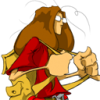UVs are necessary for "sampling" (grabbing texture pixels on shaders) textures on both direct3D and openGL.
Theres no way around it, its not to save memory, its for accessing the texture pixels (more correctly, texels, as pixels are on the screen).
So if the software/lib you used where using one of those apis, they are handling this for you.
Note that theres no "2D" concept on those apis, GPUs are rasterizers that read vertex data to shaders, shaders will work on that data and output to render targets (textures displayed on the screen).
The "3D" or "2D" is all on the api users responsibility, its all about transforming points with matrices. Those points are rasterized to the screen accordingly with the topology specified on the api (lines, triangles lists, etc.).
So, if theyr necessary for 2D game programming depends on what level* you are, if you using those apis directly you certainly need it. If not, dont worry, its being handle for you.
(*level as in low-level / high-level, not as in beginner / advanced )
--
Now, to draw things without those apis these days, I dont know if its even possible..Even windows GDI uses direcX underlying. So I dont know...Im curious, how Flash applications are drawn?? o.o anyone knows? Where are the vectors translated to pixels?
-edit-
http://help.adobe.com/en_US/as3/mobile/WS08cf58784027fd117735d34612d0a8759d1-8000.html
Crazy, flash is pretty damn fast considering the rendering madness it have to go trough










